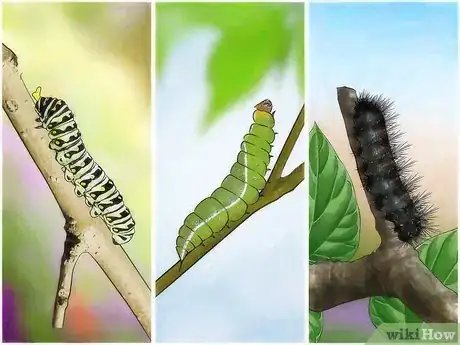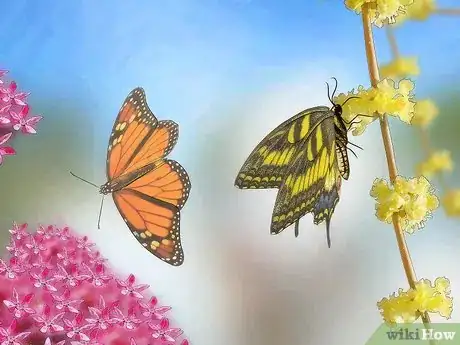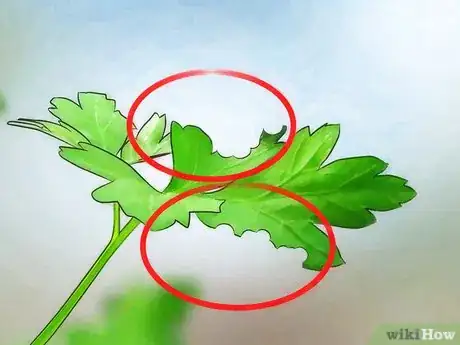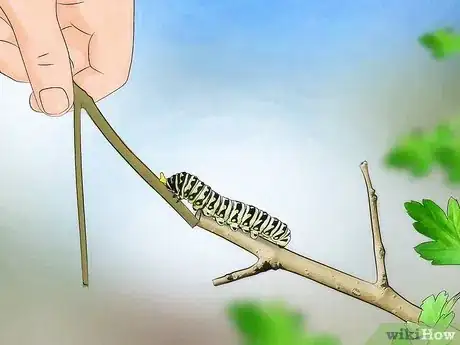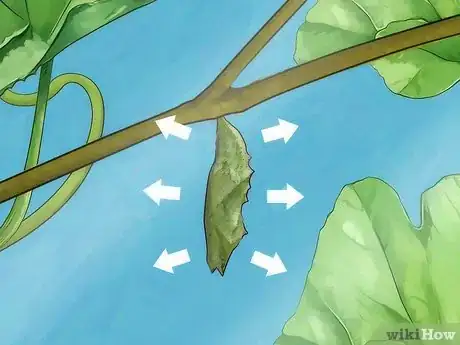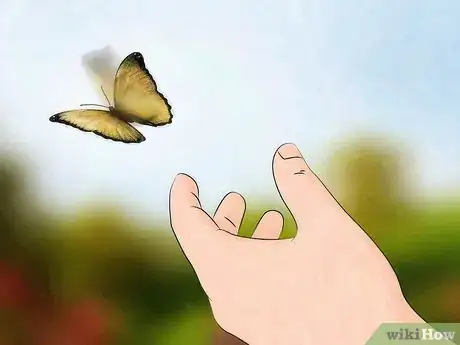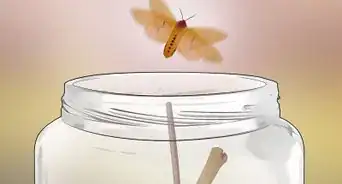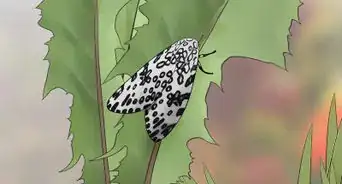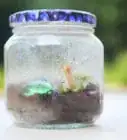This article was co-authored by Shweta Sharma. Shweta Sharma is a Biologist with the U.S. Environmental Protection Agency (EPA). With nearly ten years of experience, she specializes in insect management, integrated pest management, insect behavior, resistance management, ecology, and biological control. She earned her PhD in Urban Entomology and her MS in Environmental Horticulture from the University of Florida. She also holds a BS in Agriculture from the Institute of Agriculture and Animal Sciences, Nepal.
There are 7 references cited in this article, which can be found at the bottom of the page.
wikiHow marks an article as reader-approved once it receives enough positive feedback. This article received 21 testimonials and 100% of readers who voted found it helpful, earning it our reader-approved status.
This article has been viewed 403,018 times.
Taking care of a caterpillar until they change into a butterfly can be a rewarding experience for adults and children alike. Caterpillars make great short-term pets and watching them as they make their transition into butterflies can be beautiful. Caterpillars usually hatch from their cocoons as butterflies within 10-14 days. As long as you provide your caterpillars with food and a safe enclosure, they require very little work to keep happy and healthy as they transition into moths and butterflies.
Steps
Finding a Caterpillar
-
1Find out which caterpillars are native to your region. There are 20,000 species of butterflies on the planet, with over 725 different species in North America alone. Before going out to look for caterpillars, you may want to do some research about which caterpillars are native to the area that you live.[1]
- You can often find a list of native caterpillar or butterfly species on your state’s official website.
- Try asking the librarian at your local library to help you locate books and periodicals that can help you identify native caterpillars in your area.
- You can find a list of state wildlife websites to help you find caterpillars here: https://www.fws.gov/offices/statelinks.html
-
2Determine which kind of caterpillar you’re looking for. Once you have identified the types of caterpillars in your region, you can narrow down your search by what kind of caterpillar you’d like to have for a pet. Different kinds of caterpillars develop into different kinds of moths and butterflies, so you may choose one based on its caterpillar state, or on what type of butterfly you’d like to see emerge from the cocoon.[2]
- Some caterpillars can be dangerous to touch. You may want to take that into account when choosing a type of caterpillar to start looking for.
- You may want to choose a species of caterpillar that you have ready access to a food source for. Caterpillars prefer leaves from their “host plant” to eat.
Advertisement -
3Research the plants in your yard or area. Different kinds of caterpillars (and therefore butterflies) prefer to reside in different kinds of plants, so It’s important that you choose what kind of caterpillar you’re looking for in order to know where to look. The plant a breed of butterfly prefers is called a “host plant.” Some examples of host plants for certain species of caterpillar are:[3]
- Monarch butterfly caterpillars prefer milkweed plants.
- Spicebush Swallowtail caterpillars tend to reside in spicebush.
- Your best bet to find a Zebra Swallowtail caterpillar is in a Paw-Paw plant.
- Black Swallowtail caterpillars are commonly found in parsley, dill, or fennel plants.
- Luna moth caterpillars can be found in both walnut and sweet gum plants.
- Cecropia Moth, Viceroy or Red-Spotted Purple moth caterpillars can be found in cherry trees.
-
4Start your search in the spring. Different caterpillars are more active at different points of the year, but nearly all caterpillars can be found in the Spring and Summer months. You will likely not be able to find caterpillars beyond the early stages of fall.[4]
- Some caterpillars enter a state similar to hibernation throughout the colder months.
- Other caterpillars lay eggs that stay dormant until spring.
-
5Look for caterpillar eating damage. It may not be easy to spot a caterpillar right away. Caterpillars often blend in with their environment as a defense mechanism against predators. One way to spot a plant that likely has caterpillars in it is to look for signs that a caterpillar has been feeding on a plant recently.[5]
- Different kinds of caterpillars will leave different eating damage, so it’s important to look for the type of damage caused by the caterpillar you’re looking for.
- You can find photographic examples of different caterpillar eating damage here: http://www.raisingbutterflies.org/finding-immatures/caterpillar-strip-patterns/
-
6Catch a caterpillar by letting it come to you. Caterpillars cling tightly to the leaves and branches they are on, so pulling on it could injure the caterpillar or even pull off its legs. Instead, place your hand, a leaf or twig in the path of the caterpillar and allow it to crawl onto it to transport them.[6]
- Be careful not to touch fuzzy or spiny looking caterpillars, as the bristles you see may be a defense mechanism that can cause skin irritation.
- Always wash your hands after handling caterpillars.
- Use a field guide or a reverse image search on Google to determine which species you found.
Preparing a Caterpillar Habitat
-
1Choose a container for your caterpillar. Caterpillars do not require an elaborate enclosure to keep them safe and healthy. A one-gallon jar, fish tank or reptile enclosure will all work fine. Make sure the container has a cover and allows air to flow in and out. Line the bottom of the container with paper towels to make it easy to clean.[7]
- Cheesecloth can be used as a lid for enclosures that don’t have a top. Caterpillars cannot chew through cheesecloth but it allows air to travel in and out of the enclosure.
- If you are going to poke holes in a lid or enclosure to allow airflow, be sure the holes are very small or the caterpillar may find a way to escape through them.
-
2Add sticks or twigs to your habitat. Caterpillars need sticks and twigs to crawl around on, and eventually, to hang off of as they enter their pupae stage. Adding sticks and twigs will also make your caterpillar feel more comfortable and at home.[8]
- Make sure to place some of the sticks upright, leaned against the wall or top of the enclosure to give your caterpillar a place to climb.
- Place some sticks on their sides on the bottom of the enclosure as well.
-
3Make sure the enclosure is safe for your caterpillar. Once you have the enclosure prepared, give it a once over to make sure it looks safe for your new caterpillar friend. Caterpillars can easily injure themselves or get trapped if an enclosure isn’t safely put together.[9]
- Caterpillars can easily get cut by sharp edges in their enclosure. Make sure the areas around holes you punch are bent or sanded over so they can’t injure the caterpillar.
- Look at the ways your sticks are positioned to ensure the caterpillar couldn’t easily get trapped under or between them.
-
4Ensure there is enough space if you have more than one caterpillar. If you have more than one caterpillar in your enclosure, it’s important that you provide each caterpillar with enough space to thrive. Make sure there is at least three times the body size of each caterpillar in the enclosure.[10]
- If you plan to use the same enclosure for the caterpillars until they hatch into butterflies, you need to ensure there is enough room for them to expand their wings when they emerge from their cocoons.
Caring for Your Caterpillar
-
1Place food in your enclosure. Caterpillars eat the leaves of the host plants you often find them on. Take some of the leaves from the type of plant your particular caterpillar prefers and place them in the enclosure to serve as a food source.[11]
- Caterpillars will eat in their own time, so don’t worry if the caterpillar doesn’t begin eating as soon as you place leaves in the enclosure.
- If a caterpillar has more than one preferred host plant, add leaves from each to give the caterpillar a few choices.
- If you are unsure of a caterpillar’s host plant, add a few different kinds of leaves and see which one the caterpillar eats. Use those leaves for food from now on.
-
2Provide your caterpillars with a water source. Caterpillars need water added to their enclosure on a daily basis. Do not place a water dish in your enclosure as caterpillars may fall into them and drown. Instead, simply spray some water onto the leaves each day and the caterpillars will drink from the droplets.[12]
- Instead of spraying water onto the leaves, you can simply rinse them before you place them in the enclosure, that will provide enough water.
- If your caterpillar begins to look very dry, try spraying more water into the enclosure.
-
3Clean the enclosure every day. You will need to remove uneaten leaves on a regular basis. Depending on the plant, leaves may last up to a week, or they may begin to dry out after only a few days. You may also want to replace the paper towels you place at the bottom of the enclosure as bedding.[13]
- Replacing the bedding will remove caterpillar droppings and waste that could cause caterpillars to get sick.
- Remove old leaves any time you place new leaves in the enclosure.
-
4Relocate the caterpillar pupae. If your container does not allow enough room for your caterpillars to emerge from their cocoon and spread their wings, you will need to relocate the cocoons to a larger enclosure once they enter them.[14]
- Make sure the new enclosure has enough space for the butterflies to emerge from their cocoons and spread their wings.
- Be very gentle when removing the cocoons. You can handle them with your hands as long as you are very careful.
Taking Care of Butterfly Pupae
-
1Hang the cocoon in its own container. If you are relocating your butterfly cocoons, you may want to simply move the twig it’s hanging from into a new, larger space. If that isn’t an option, there are a few ways you can hang the cocoons in their new habitat.[15]
- You can use the glue from a hot glue gun, cooled slightly so it’s tacky, to attach the pointy end of the cocoon to a twig.
- You can puncture the pointy end of the cocoon with a needle and thread to hang it in your enclosure, but this can be dangerous, as you may hurt the caterpillar inside.
-
2Base your anticipated timeline on the season. Most caterpillars will hatch from their cocoons as butterflies within ten to fourteen days, but some may not emerge from their cocoon at all during the winter months.[16]
- In the Spring and Summer months, caterpillars will emerge as butterflies at the fastest rate.
- In the Fall, some caterpillar breeds may remain inside the cocoon for extended periods of time.
-
3Look for the cocoon to change color. You will know that the butterfly will emerge from its cocoon soon when it changes colors. Some turn darker in color while others become clear, depending on the species of moth or butterfly inside.[17]
- If the color of the cocoon changes, the butterfly will likely emerge within the next day or two.
- If a cocoon’s color becomes extremely dark, it is likely that the caterpillar inside died.
-
4Provide food for your butterfly. Many butterflies and moths do not have digestive tracts once they reach the butterfly stage of their lives. These butterflies and moths usually only have a lifespan of a few days. Some others can and do eat. Make sure to provide some leaves from the host plant species of that butterfly in case your butterfly or moth eats.[18]
- You may want to release your butterfly or moth at this point so it can pursue a mate.
- To release a moth or butterfly, simply open the container outside and allow it to fly away.
- You can also feed adult butterflies sugar water.
Community Q&A
-
QuestionHow long does it take after the caterpillar hatches for it to begin building the cocoon?
 Community AnswerFor the caterpillar to hatch from its egg it might take about a week or less and for the caterpillar to hatch from its chrysalis or cocoon it takes about 9 to 14 days.
Community AnswerFor the caterpillar to hatch from its egg it might take about a week or less and for the caterpillar to hatch from its chrysalis or cocoon it takes about 9 to 14 days. -
QuestionWhat if my caterpillar is turning dark?
 Community AnswerIf your caterpillar is slightly dark, then it's not quite healthy and may have been attacked by a parasite. If your caterpillar has become very dark (like a dark red or black) then it has probably died. But don't lose hope, keep the "dead" caterpillar for a few days more. If it is still not moving, then it has died, in which case, you'll need to bury it and get another caterpillar.
Community AnswerIf your caterpillar is slightly dark, then it's not quite healthy and may have been attacked by a parasite. If your caterpillar has become very dark (like a dark red or black) then it has probably died. But don't lose hope, keep the "dead" caterpillar for a few days more. If it is still not moving, then it has died, in which case, you'll need to bury it and get another caterpillar. -
QuestionHow big does the container have to be?
 Community AnswerThe container should be big enough for a nice amount of food and posts, places for them to hang on when it's time to transform into a butterfly. It should also be big enough for them to spread their wings to dry before you can release them.
Community AnswerThe container should be big enough for a nice amount of food and posts, places for them to hang on when it's time to transform into a butterfly. It should also be big enough for them to spread their wings to dry before you can release them.
References
- ↑ http://www.naba.org/qanda.html
- ↑ http://www.discoverlife.org/mp/20q?guide=Caterpillars
- ↑ http://www.butterflyschool.org/teacher/raising.html
- ↑ http://www.raisingbutterflies.org/finding-immatures/
- ↑ http://www.raisingbutterflies.org/finding-immatures/caterpillar-strip-patterns/
- ↑ http://www.butterflyschool.org/teacher/raising.html
- ↑ http://www.butterflyschool.org/teacher/raising.html
- ↑ http://www.butterflyschool.org/teacher/raising.html
- ↑ http://www.keepinginsects.com/butterfly/care/
- ↑ http://www.keepinginsects.com/butterfly/care/
- ↑ http://www.keepinginsects.com/butterfly/care/
- ↑ http://www.keepinginsects.com/butterfly/care/
- ↑ http://www.keepinginsects.com/butterfly/care/
- ↑ http://www.keepinginsects.com/butterfly/care/
- ↑ http://www.keepinginsects.com/butterfly/care/
- ↑ http://www.butterflyschool.org/teacher/raising.html
- ↑ http://www.butterflyschool.org/teacher/raising.html
- ↑ http://www.butterflyschool.org/teacher/raising.html
About This Article
To take care of a caterpillar, keep it in a covered container that has holes so air can get in. Fill the container with sticks and twigs so your caterpillar has things to climb on and hang off of when it starts to turn into a butterfly. You should also look up what kind of leaves your caterpillar eats in the wild and then put some of them in the container so it has food. Also, spray the leaves with water every day to keep your caterpillar hydrated. To learn how to care for your caterpillar once it starts to turn into a butterfly, scroll down!
